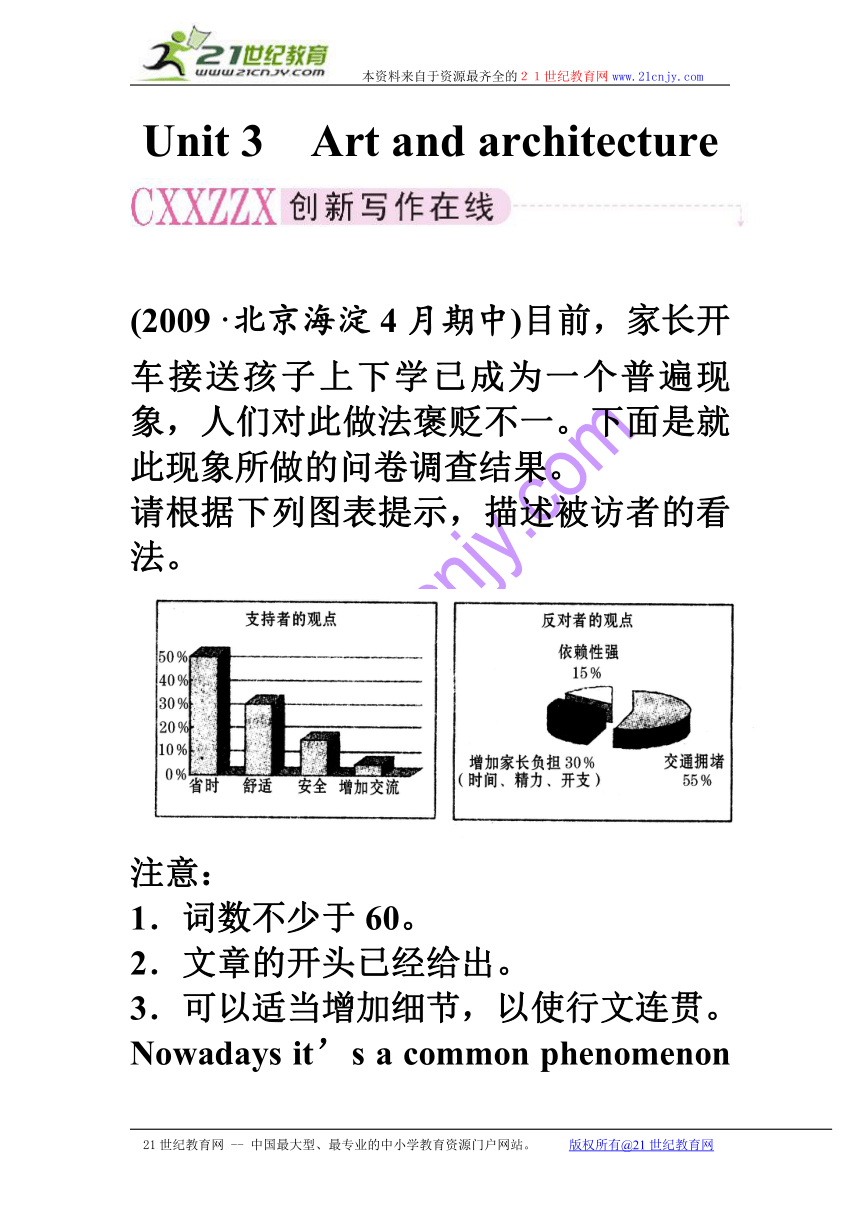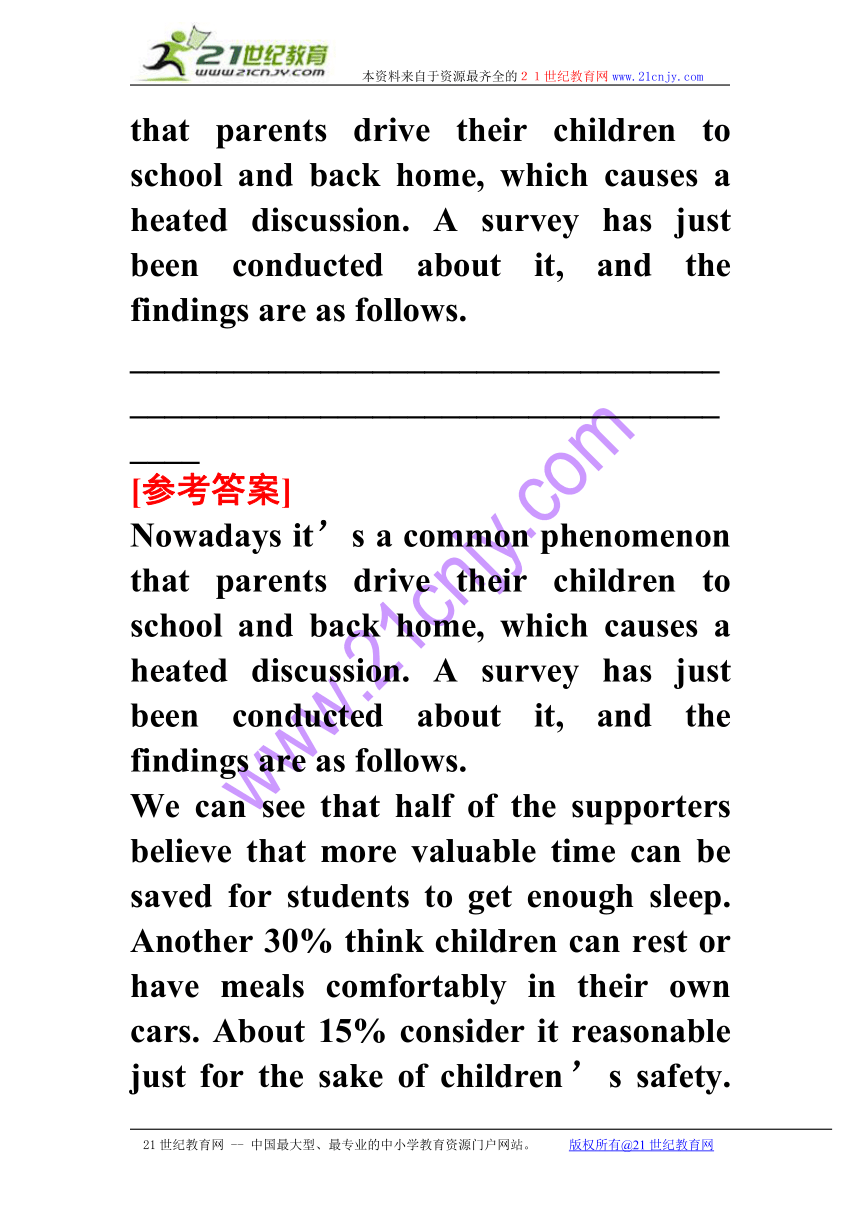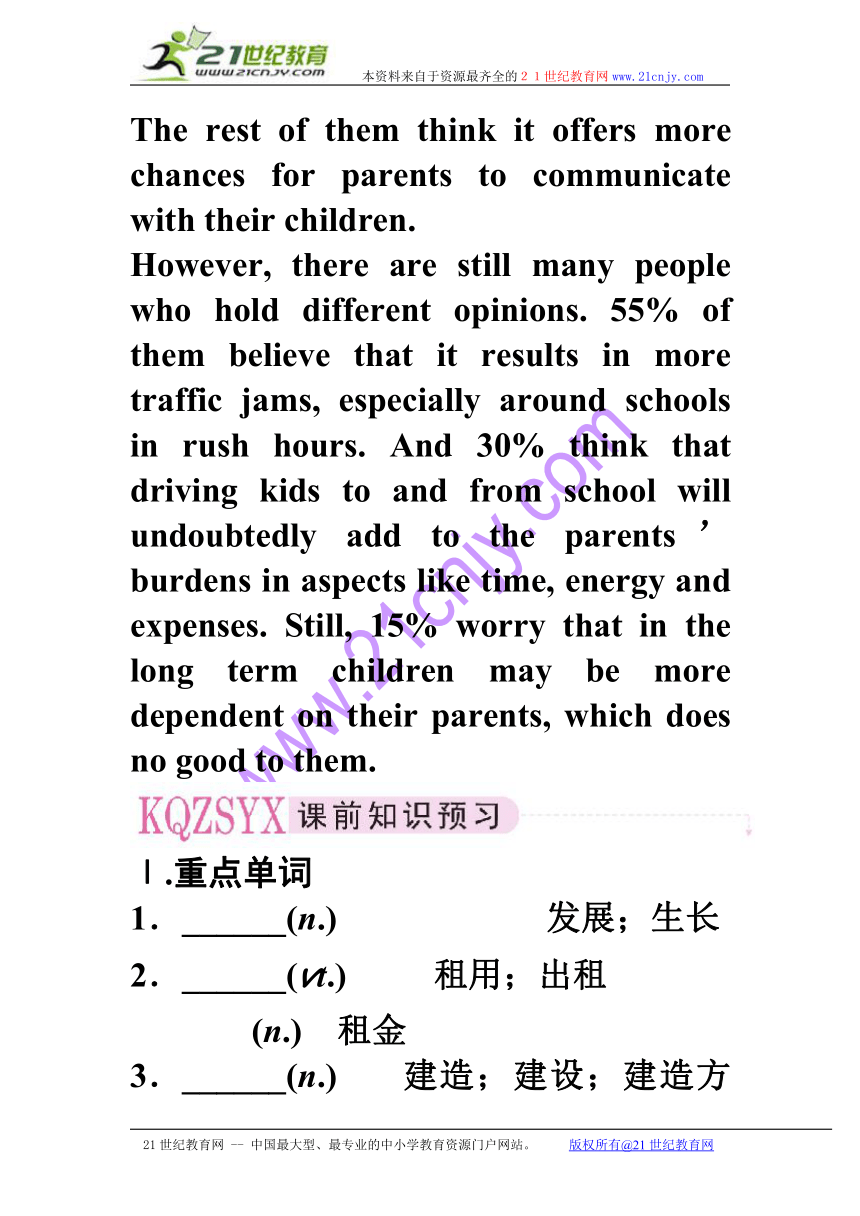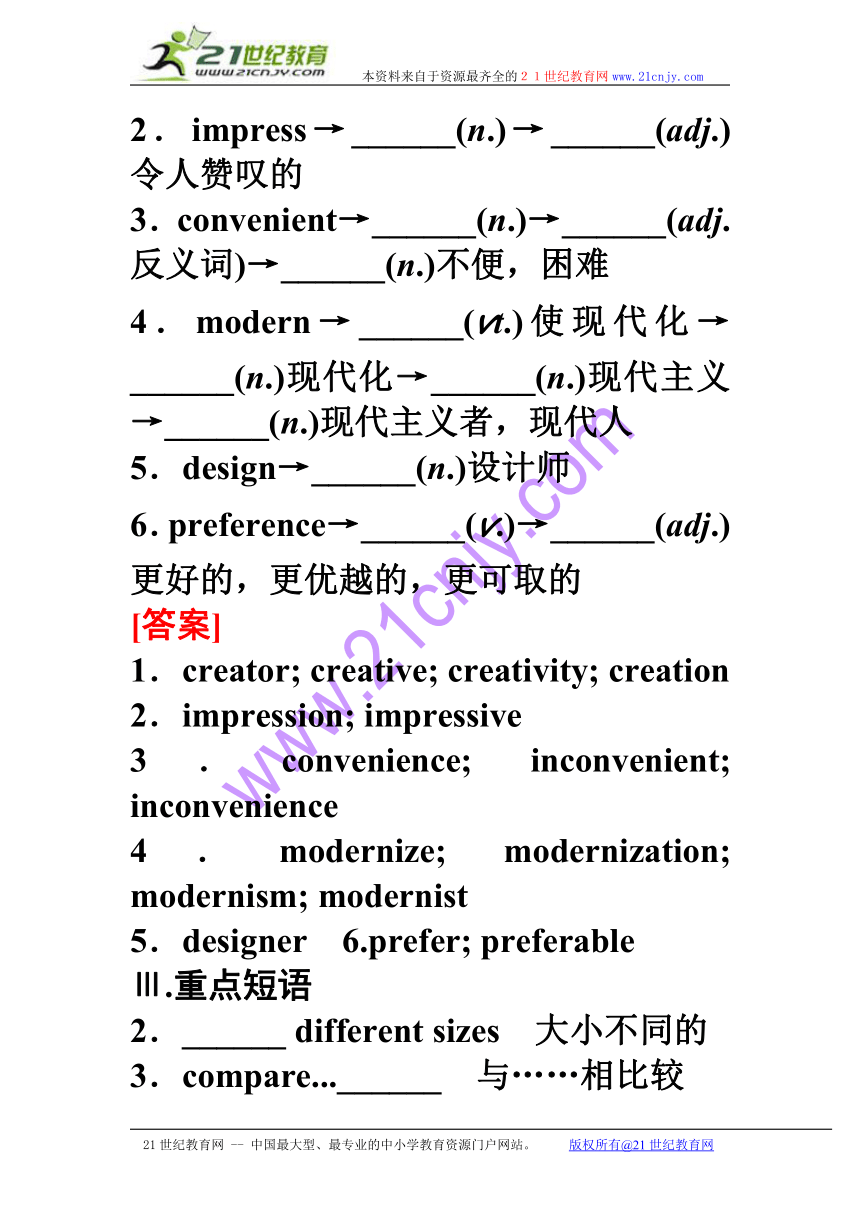备考2011高效学习方案英语高二册:unit 3 art and architecture
文档属性
| 名称 | 备考2011高效学习方案英语高二册:unit 3 art and architecture |  | |
| 格式 | rar | ||
| 文件大小 | 348.2KB | ||
| 资源类型 | 教案 | ||
| 版本资源 | 人教版 | ||
| 科目 | 英语 | ||
| 更新时间 | 2010-12-14 17:11:00 | ||
图片预览





文档简介
本资料来自于资源最齐全的21世纪教育网www.21cnjy.com
Unit 3 Art and architecture
(2009·北京海淀4月期中)目前,家长开车接送孩子上下学已成为一个普遍现象,人们对此做法褒贬不一。下面是就此现象所做的问卷调查结果。
请根据下列图表提示,描述被访者的看法。
注意:
1.词数不少于60。
2.文章的开头已经给出。
3.可以适当增加细节,以使行文连贯。
Nowadays it’s a common phenomenon that parents drive their children to school and back home, which causes a heated discussion. A survey has just been conducted about it, and the findings are as follows.
________________________________________________________________________
[参考答案]
Nowadays it’s a common phenomenon that parents drive their children to school and back home, which causes a heated discussion. A survey has just been conducted about it, and the findings are as follows.
We can see that half of the supporters believe that more valuable time can be saved for students to get enough sleep. Another 30% think children can rest or have meals comfortably in their own cars. About 15% consider it reasonable just for the sake of children’s safety. The rest of them think it offers more chances for parents to communicate with their children.
However, there are still many people who hold different opinions. 55% of them believe that it results in more traffic jams, especially around schools in rush hours. And 30% think that driving kids to and from school will undoubtedly add to the parents’ burdens in aspects like time, energy and expenses. Still, 15% worry that in the long term children may be more dependent on their parents, which does no good to them.
Ⅰ.重点单词
1.______(n.) 发展;生长
2.______(vt.) 租用;出租
(n.) 租金
3.______(n.) 建造;建设;建造方法;
建造物
4.______(vt.) 建造;建设
5.______(vt.) 忍受;经受;承担
6.______(n.) 大建筑物;一排房屋;街区;
大块(木料、石料或金属)
7.______(n.) (总称)家具
8.______(n.) 建筑学;建筑业;(总称)建筑
物;建筑风格
[答案]
1.development 2.rent 3.construction 4.construct
5.stand 6.block 7.furniture 8.architecture
Ⅱ.词汇拓展
1.create→______(n.)创造者,创建者→______(adj.)创造性的→______(n.)创造力→______(n.)创造,创作物
2.impress→______(n.)→______(adj.)令人赞叹的
3.convenient→______(n.)→______(adj.反义词)→______(n.)不便,困难
4.modern→______(vt.)使现代化→______(n.)现代化→______(n.)现代主义→______(n.)现代主义者,现代人
5.design→______(n.)设计师
6.preference→______(v.)→______(adj.)更好的,更优越的,更可取的
[答案]
1.creator; creative; creativity; creation
2.impression; impressive
3.convenience; inconvenient; inconvenience
4.modernize; modernization; modernism; modernist
5.designer 6.prefer; preferable
Ⅲ.重点短语
2.______ different sizes 大小不同的
3.compare...______ 与……相比较
4.be ______ with 用……来装饰
5.______ down 拆毁;摧毁;推翻
6.______ in doing sth. 成功做成某事
7.look ______ 环视四周
8.go ______ 违背,违反
9.set ______ 把……置于一旁;留出;拨出
10.______ to 属于;是……成员
11.fill ______ with... 用……装满
12.act ______ 充当;扮演;担当
13.be ______ to do sth. 自由地或不受约束地做……
[答案]
1.of 2.of 3.with 4.decorated 5.pull 6.succeed
7.around 8.against 9.aside 10.belong 11.up
12.as 13.free
Ⅳ.重点句型
1....you will find them designed, planned and built in different styles.
……你会发现它们是用不同的风格设计、规划和建造起来的。
2.Seen from the top, it looks as if the stadium is covered by...
从顶部看,体育馆就好像被……覆盖。
3.A is to B what C is to D.
A对于B就如C对于D一样。
4....with old factories turned into successful arts centre.
……由旧工厂被变成了成功的艺术中心。
Ⅴ.重点语法
The Past Participle Used as Object Complement(过去分词作宾语补足语)
Ⅰ.词汇聚焦
1.convenient adj. 方便的,便利的[反]inconvenient
[指点迷津]
convenient不用来修饰人,常用来指事。构成短语:be convenient to sb.表示“对某人来说方便”;be convenient for sb. to do sth.表示“对某人来说做某事方便”。
①If it is convenient to you today, please post the letter for me on your way home.
②Will it be convenient for you to start work tomorrow
2.stand vt. 忍受,忍耐;承担,经受
[思维拓展]
stand+n. 忍受……,经受住
stand doing/to do忍耐做,忍受做
stand vi. 处于……的状态,情况如何
as things now stand照现在的情况看
[指点迷津]
stand表示“忍受,忍耐”,多用于否定句、疑问句,不用于进行时。
①This color won’t stand washing.
②I can’t stand this hot weather.
③The door stood open.
3.impress vt. 铭刻,给……极深的印象;使感动 impression n.
[思维拓展]
impress...on...把……印在……上
be impressed by/at/with被……所感动
be impressed on one’s mind/memory
被印在某人的脑海里
leave/make a(n)...impression on sb.
给某人留下……的印象
①His parents try to impress on him that it’s very important to be honest.
②All that made a lasting impression on him.
③His words were deeply impressed on her mind.
______ by his words, all the audience clapped now and then.
A. Impressed B. Impressing
C. Being impressed D. Having impressed
解析:根据上下句的语意及逻辑,impress与the audience之间应构成逻辑上的动宾关系,故应该用过去分词表示被动。
答案:A
4.furniture n. [U] 家具
[思维拓展]
①a piece of furniture
=an article of furniture一件家具
a set of furniture一套家具
pieces/articles of furniture多件家具
②furnish sb. with sth.为某人装备/提供……
furnish sth. to sb.向某人提供/装备……
They bought a new house and a lot of furniture, and soon moved in.
The furniture he bought yesterday ______ of high quality.
A. has B. have
C. is D. are
解析:he bought yesterday是定语从句修饰furniture。furniture是不可数名词,故先排除B和D。be of+n.是固定结构,如果用has,必须去掉of。
答案:C
5.taste n. 爱好,嗜好;鉴赏力;滋味,味道;v. 品尝,尝起来(link v.)
[思维拓展]
have a/an...taste有……的味道
show good taste in...对……有鉴赏力
have a taste for/in...喜好……
to one’s taste合某人的口味
to taste按口味
in good taste雅致;(行为)高尚
taste+adj. (sweet, bitter, sour, salty)尝起来(甜的、苦的、酸的、咸的)
taste+n. 品尝某物
①The food has an attractive taste.
②She shows good taste in water-colours.
His jokes about the president’s illness were in poor ______.
A. interest B. taste
C. benefit D. thought
解析:本题句意为“他那些关于总统生病的笑话格调很低”。A项表示“兴趣,趣味”;C项为“益处,利益”;D项为“想法,思想”。
答案:B
6.design v. 谋划;设计,构思,n. 图案,花样;设计,计划
[思维拓展]
design (sb.) sth.(为某人)设计某物
design doing/to do sth.筹划做某事
design that...打算……
design sb. to do sth.打算让某人做某事
be designed for打算用来做……
a hopeless design毫无希望的计划
a beautiful design美丽的图案
by design故意地,蓄意地(=on purpose)
①They designed building/to build a house there.
②He designed me the dress.
③They designed their son to be a doctor.
Whether by accident or by ______, he arrived too late to help us.
A. purpose B. aim
C. design D. chance
解析:purpose与介词on搭配,chance与by搭配,表示“偶然地”;design与by搭配,表示“故意地,蓄意地”。
答案:C
7.development n. 发展;develop v. 形成,培养,发展,冲洗
[思维拓展]
develop a new business发展新业务
develop mind and body身心发展
develop speaking skills培养会话技巧
develop a film冲洗胶卷
develop...out of/from由……发展起来
develop...into...发展……成为……
Paper making began in China and from here it ______ to North Africa and Europe.
A. spread B. grew
C. carried D. developed
解析:本题考查的是动词的意义。spread“传播;蔓延”;grow“生长;变得”;carry“随身携带”;develop“发展”。根据句意,“造纸业开始于中国,从中国传到了北非和欧洲”。故应选择spread。
答案:A
Ⅱ.短语突破
1.be interested to do sth.想做某事;有兴趣做某事
[思维拓展]
be interested in...对……感兴趣
of interest (=interesting)有意思的
with interest感兴趣地
take/have/feel an interest in对……感兴趣
his two interests他的两大爱好
an interest in a business一个企业的股份
put the interests of people before all else
把人民利益放在一切之首
to one’s interest符合……的利益,对……有好处
It is believed that if a book is ______, it will surely ______ the reader.
A. interested; interest
B. interesting; be interested
C. interested; be interesting
D. interesting; interest
解析:第一空格需要形容词作表语并说明主语the book的性质特点,所以用interesting,意思是“有趣的”;第二空格需要动词原形跟在will后构成谓语,用interest,意思是“使……感兴趣”。
答案:D
2.belong to vi. 属于,是……的成员,是……的组成部分,是……的属性(职能等)
[指点迷津]
belong to不用于进行时和被动语态;belong也可与介词短语或副词连用,表示“适合呆在或放在某处”。
①All the goods here belong to the school.
②Who does this garden belong to
3.contribute to (to为介词)
[思维拓展]
捐献,贡献contribute (sth.) to...
投稿
提供(时间、精力等)
有助于,促使(某事发生)
为……出力/作贡献
contribution n. 贡献
make a contribution to为……作贡献(to为介词)
①He contributed to the church.
②Cigarette smoking is a major factor contributing to cancer.(吸烟是导致癌症的主要因素。)
We hope your suggestion will contribute ______ the problem.
A. to solving B. to solve
C. solve D. solved
解析:contribute to中的to为介词,后面可跟doing/sth./pron.。
答案:A
3.act as 充当;担任……的职务;起……作用
[思维拓展]
serve as...当……,做……
work as...当……,做……
use...as...把……用作……
treat...as...把……看作……
accept...as...把……作为……
①The chemical acted as a catalyst(催化剂).
②He serves as a waiter in the restaurant.
Mary finally ______ Bruce as her lifelong companion.
A. received B. accepted
C. made D. honored
解析:句意指主观上接受。
答案:B
4.fill up with用……填上;装满……
[思维拓展]
fill up a form填表
fill it up with water把它装满水
fill in填上,代替,消磨掉
[指点迷津]
be filled with强调动作;be full of强调状态。
①Could you fill me in on what happened at the meeting
②The room soon filled up (with people).
9.set aside把……放在一边;搁置;拨出;不理会
[思维拓展]
move aside把……移到一边
step aside站到一边
aside from除……之外;既……又……
lay aside储蓄
①She stepped aside to let them pass.
②Let’s leave that problem aside for the moment.
③Aside from being fun and good exercise, swimming is a very useful skill.
—It’s a good idea. But who’s going to ______ the plan
—I think Tom and Greg will.
A. set aside B. carry out
C. take in D. get through
解析:carry out“执行,实现,完成”;set aside“留出,储蓄”;take in“接收,吸收,理解”;get through“做完,通过,接通电话”,由句意可知“由谁来实施这个计划”。
答案:B
5.stand out
[思维拓展]
显得突出,显眼,引人注目
坚决反对或抵抗,坚持
站出来;拒绝跟别人一起参加活动
支撑住,熬过
①As he hasn’t recovered from illness, he will stand out in the next football match.
②We’ll stand out till victory.
Yao Ming ______ as a basketball star, and is loved by basketball fans both at home and abroad.
A. stands out B. stands up
C. sticks out D. strikes
解析:根据语境,此处应表示“突出”之意。
答案:A
6.go against违背;反对
[思维拓展]
act against违反
fight against为反对……而战
speak against发言抨击
struggle against同……作斗争
stand against靠……站着
be strongly against强烈反对
be against one’s will违背……的意愿
be against the law违法
①She went against her mother’s wishes.
②They are strongly against the idea.
③The rain beat against the windows.
He tried to slip into the classroom without being noticed, but luck ______ him.
A. went against B. fought against
C. acted against D. against
解析:句子的意思是“事与愿违”,而且but引导并列分句,所以使用went against。fight against的意思是“与……作斗争”不符合题意;against是介词,不能单独用作谓语动词。
答案:A
Ⅲ.句型归纳
1.Old factory buildings have many halls and workshops of different sizes.旧的工厂建筑物有许多大小不一的大厅和工作间。
该句中of+n.常用来表示人或事物所具有的特征或性质,在句中常用来作表语或后置定语。
[思维拓展]
①be of+抽象名词=be+抽象名词对应的形容词,抽象名词前可加great, much, a bit, some, little, no等词。
be of great value/use/help/importance/significance=be+very valuable/useful/helpful/important/significant
②be of+size/age/colour/type/weight/height/width/depth, of后还可加a/an/the/the same/different等词。
The two boys are of the same age but of different height.
You’ll find this map of great ______ in helping you to get round London.
A. price B. cost
C. value D. importance
解析:此处为“be of+抽象名词”句型。句意为“你会发现这张地图对你在伦敦旅游大有益处”,A、B两项不合句意,D项为可数名词,value为抽象名词,意为“益处,价值”。
答案:C
The naughty boys have been playing with my hat—they’ve knocked it out of ______.
A. shape B. size
C. control D. line
解析:out of shape“走样,变形”;out of control“失去控制”;out of line“出线”。由句意“把它(帽子)弄得不成样了”。
答案:A
2.Well, I must say I’d rather live in a traditional siheyuan.依我看,我宁愿住在传统的四合院里。
would rather表示“宁愿”,表达选择之意。
[思维拓展]
would rather (not) do宁愿(不)做……
would rather do...than do宁愿做……不愿做
would do...rather than do宁愿做……不愿做
prefer to do...rather than do宁愿做……不愿做
[指点迷津]
would rather表示选择,后跟宾语从句要用虚拟语气。动词用过去时或过去完成时。
rather than则表示否定。
other than表示“除了……”;“绝不是”。
①I would rather die than give in.=I would die rather than give in.
②I would rather you didn’t tell him about that.
③I decided to write rather than to telephone.
④You can’t get there other than by boat.
3.Seen from the top, it looks as if the stadium is covered by a gray net of steel, and it looks just like a bird’s nest made of tree branches.从顶部看,体育馆好像是覆盖着一张灰色的钢网,看起来正像是用树枝搭成的鸟窝。
[思维拓展]
①see“看”,由其构成的过去分词短语在句中作状语,与句子的主语it(the stadium)存在被动关系。
Seen from the top of the hill, the city looks very beautiful.
②如果分词所表示的动作是主句的主语发出来的,即它与主语间存在着主动关系,则用现在分词短语作状语。
Not knowing his address, I can’t write to him.
With ______ leaves ______ in the earth every year, the soil becomes richer and richer.
A. falling; burying B. fallen; burying
C. fallen; buried D. falling; buried
解析:falling leaves是“正在下落的叶子”,fallen leaves是“落下来的叶子”;树叶是被埋在土壤里用buried过去分词。
答案:C
4.Painters and other artists can move into the smaller rooms to use them as studios to paint, while music bands rent space to practise.画家以及其他艺术家可以搬入小一点的房间把它们当画室,而乐队则可以租赁空间进行排练。
[指点迷津]
while常用来引导时间状语从句,而此处它被用作并列连词,表示转折或对照。
while用来引导时间状语从句时,从句中的谓语动词必须是延续性动词。
while还可以引导让步状语从句。
①He is busy doing homework, while his brother is playing computer games.
②When he came in, we were all at table.
She thought I was talking about her daughter, ______, in fact, I was talking about my daughter.
A. whom B. where
C. which D. while
解析:in fact是插入语,略去不管,然后可看出这是个表示对比和转折意义的并列句,是由并列连词while“然而”连接的。
答案:D
5....and twenty-foot high walls of glass that make them special when compared with other architecture from the same period.……以及20英尺高的玻璃墙,这些玻璃墙使它们在与同期的其他建筑相比时与众不同。
when compared...是when they are compared...的省略形式。
[思维拓展]
compare...with...把……与……相比
compare...to...把……比作……
compared to/with...与……相比(可在句中作状语)
don’t/can’t compare with...
不能与……相比;比不上……
①Compare this sentence with that one, and you’ll see the difference.
②One’s life is often compared to a candle.
③Compared with the others, you’re really lucky.
When ______, the museum will be open to the public next year.
A. completed B. completing
C. being completed D. to be completed
解析:该题从句使用了省略形式,省略了与主句主语一致的主语the museum以及系动词is。在状语从句中,若主语与主句的主语一致或主语是it,同时谓语又含有系动词be时,可省去从句中的主语和系动词be。
答案:A
21世纪教育网 -- 中国最大型、最专业的中小学教育资源门户网站。 版权所有@21世纪教育网
Unit 3 Art and architecture
(2009·北京海淀4月期中)目前,家长开车接送孩子上下学已成为一个普遍现象,人们对此做法褒贬不一。下面是就此现象所做的问卷调查结果。
请根据下列图表提示,描述被访者的看法。
注意:
1.词数不少于60。
2.文章的开头已经给出。
3.可以适当增加细节,以使行文连贯。
Nowadays it’s a common phenomenon that parents drive their children to school and back home, which causes a heated discussion. A survey has just been conducted about it, and the findings are as follows.
________________________________________________________________________
[参考答案]
Nowadays it’s a common phenomenon that parents drive their children to school and back home, which causes a heated discussion. A survey has just been conducted about it, and the findings are as follows.
We can see that half of the supporters believe that more valuable time can be saved for students to get enough sleep. Another 30% think children can rest or have meals comfortably in their own cars. About 15% consider it reasonable just for the sake of children’s safety. The rest of them think it offers more chances for parents to communicate with their children.
However, there are still many people who hold different opinions. 55% of them believe that it results in more traffic jams, especially around schools in rush hours. And 30% think that driving kids to and from school will undoubtedly add to the parents’ burdens in aspects like time, energy and expenses. Still, 15% worry that in the long term children may be more dependent on their parents, which does no good to them.
Ⅰ.重点单词
1.______(n.) 发展;生长
2.______(vt.) 租用;出租
(n.) 租金
3.______(n.) 建造;建设;建造方法;
建造物
4.______(vt.) 建造;建设
5.______(vt.) 忍受;经受;承担
6.______(n.) 大建筑物;一排房屋;街区;
大块(木料、石料或金属)
7.______(n.) (总称)家具
8.______(n.) 建筑学;建筑业;(总称)建筑
物;建筑风格
[答案]
1.development 2.rent 3.construction 4.construct
5.stand 6.block 7.furniture 8.architecture
Ⅱ.词汇拓展
1.create→______(n.)创造者,创建者→______(adj.)创造性的→______(n.)创造力→______(n.)创造,创作物
2.impress→______(n.)→______(adj.)令人赞叹的
3.convenient→______(n.)→______(adj.反义词)→______(n.)不便,困难
4.modern→______(vt.)使现代化→______(n.)现代化→______(n.)现代主义→______(n.)现代主义者,现代人
5.design→______(n.)设计师
6.preference→______(v.)→______(adj.)更好的,更优越的,更可取的
[答案]
1.creator; creative; creativity; creation
2.impression; impressive
3.convenience; inconvenient; inconvenience
4.modernize; modernization; modernism; modernist
5.designer 6.prefer; preferable
Ⅲ.重点短语
2.______ different sizes 大小不同的
3.compare...______ 与……相比较
4.be ______ with 用……来装饰
5.______ down 拆毁;摧毁;推翻
6.______ in doing sth. 成功做成某事
7.look ______ 环视四周
8.go ______ 违背,违反
9.set ______ 把……置于一旁;留出;拨出
10.______ to 属于;是……成员
11.fill ______ with... 用……装满
12.act ______ 充当;扮演;担当
13.be ______ to do sth. 自由地或不受约束地做……
[答案]
1.of 2.of 3.with 4.decorated 5.pull 6.succeed
7.around 8.against 9.aside 10.belong 11.up
12.as 13.free
Ⅳ.重点句型
1....you will find them designed, planned and built in different styles.
……你会发现它们是用不同的风格设计、规划和建造起来的。
2.Seen from the top, it looks as if the stadium is covered by...
从顶部看,体育馆就好像被……覆盖。
3.A is to B what C is to D.
A对于B就如C对于D一样。
4....with old factories turned into successful arts centre.
……由旧工厂被变成了成功的艺术中心。
Ⅴ.重点语法
The Past Participle Used as Object Complement(过去分词作宾语补足语)
Ⅰ.词汇聚焦
1.convenient adj. 方便的,便利的[反]inconvenient
[指点迷津]
convenient不用来修饰人,常用来指事。构成短语:be convenient to sb.表示“对某人来说方便”;be convenient for sb. to do sth.表示“对某人来说做某事方便”。
①If it is convenient to you today, please post the letter for me on your way home.
②Will it be convenient for you to start work tomorrow
2.stand vt. 忍受,忍耐;承担,经受
[思维拓展]
stand+n. 忍受……,经受住
stand doing/to do忍耐做,忍受做
stand vi. 处于……的状态,情况如何
as things now stand照现在的情况看
[指点迷津]
stand表示“忍受,忍耐”,多用于否定句、疑问句,不用于进行时。
①This color won’t stand washing.
②I can’t stand this hot weather.
③The door stood open.
3.impress vt. 铭刻,给……极深的印象;使感动 impression n.
[思维拓展]
impress...on...把……印在……上
be impressed by/at/with被……所感动
be impressed on one’s mind/memory
被印在某人的脑海里
leave/make a(n)...impression on sb.
给某人留下……的印象
①His parents try to impress on him that it’s very important to be honest.
②All that made a lasting impression on him.
③His words were deeply impressed on her mind.
______ by his words, all the audience clapped now and then.
A. Impressed B. Impressing
C. Being impressed D. Having impressed
解析:根据上下句的语意及逻辑,impress与the audience之间应构成逻辑上的动宾关系,故应该用过去分词表示被动。
答案:A
4.furniture n. [U] 家具
[思维拓展]
①a piece of furniture
=an article of furniture一件家具
a set of furniture一套家具
pieces/articles of furniture多件家具
②furnish sb. with sth.为某人装备/提供……
furnish sth. to sb.向某人提供/装备……
They bought a new house and a lot of furniture, and soon moved in.
The furniture he bought yesterday ______ of high quality.
A. has B. have
C. is D. are
解析:he bought yesterday是定语从句修饰furniture。furniture是不可数名词,故先排除B和D。be of+n.是固定结构,如果用has,必须去掉of。
答案:C
5.taste n. 爱好,嗜好;鉴赏力;滋味,味道;v. 品尝,尝起来(link v.)
[思维拓展]
have a/an...taste有……的味道
show good taste in...对……有鉴赏力
have a taste for/in...喜好……
to one’s taste合某人的口味
to taste按口味
in good taste雅致;(行为)高尚
taste+adj. (sweet, bitter, sour, salty)尝起来(甜的、苦的、酸的、咸的)
taste+n. 品尝某物
①The food has an attractive taste.
②She shows good taste in water-colours.
His jokes about the president’s illness were in poor ______.
A. interest B. taste
C. benefit D. thought
解析:本题句意为“他那些关于总统生病的笑话格调很低”。A项表示“兴趣,趣味”;C项为“益处,利益”;D项为“想法,思想”。
答案:B
6.design v. 谋划;设计,构思,n. 图案,花样;设计,计划
[思维拓展]
design (sb.) sth.(为某人)设计某物
design doing/to do sth.筹划做某事
design that...打算……
design sb. to do sth.打算让某人做某事
be designed for打算用来做……
a hopeless design毫无希望的计划
a beautiful design美丽的图案
by design故意地,蓄意地(=on purpose)
①They designed building/to build a house there.
②He designed me the dress.
③They designed their son to be a doctor.
Whether by accident or by ______, he arrived too late to help us.
A. purpose B. aim
C. design D. chance
解析:purpose与介词on搭配,chance与by搭配,表示“偶然地”;design与by搭配,表示“故意地,蓄意地”。
答案:C
7.development n. 发展;develop v. 形成,培养,发展,冲洗
[思维拓展]
develop a new business发展新业务
develop mind and body身心发展
develop speaking skills培养会话技巧
develop a film冲洗胶卷
develop...out of/from由……发展起来
develop...into...发展……成为……
Paper making began in China and from here it ______ to North Africa and Europe.
A. spread B. grew
C. carried D. developed
解析:本题考查的是动词的意义。spread“传播;蔓延”;grow“生长;变得”;carry“随身携带”;develop“发展”。根据句意,“造纸业开始于中国,从中国传到了北非和欧洲”。故应选择spread。
答案:A
Ⅱ.短语突破
1.be interested to do sth.想做某事;有兴趣做某事
[思维拓展]
be interested in...对……感兴趣
of interest (=interesting)有意思的
with interest感兴趣地
take/have/feel an interest in对……感兴趣
his two interests他的两大爱好
an interest in a business一个企业的股份
put the interests of people before all else
把人民利益放在一切之首
to one’s interest符合……的利益,对……有好处
It is believed that if a book is ______, it will surely ______ the reader.
A. interested; interest
B. interesting; be interested
C. interested; be interesting
D. interesting; interest
解析:第一空格需要形容词作表语并说明主语the book的性质特点,所以用interesting,意思是“有趣的”;第二空格需要动词原形跟在will后构成谓语,用interest,意思是“使……感兴趣”。
答案:D
2.belong to vi. 属于,是……的成员,是……的组成部分,是……的属性(职能等)
[指点迷津]
belong to不用于进行时和被动语态;belong也可与介词短语或副词连用,表示“适合呆在或放在某处”。
①All the goods here belong to the school.
②Who does this garden belong to
3.contribute to (to为介词)
[思维拓展]
捐献,贡献contribute (sth.) to...
投稿
提供(时间、精力等)
有助于,促使(某事发生)
为……出力/作贡献
contribution n. 贡献
make a contribution to为……作贡献(to为介词)
①He contributed to the church.
②Cigarette smoking is a major factor contributing to cancer.(吸烟是导致癌症的主要因素。)
We hope your suggestion will contribute ______ the problem.
A. to solving B. to solve
C. solve D. solved
解析:contribute to中的to为介词,后面可跟doing/sth./pron.。
答案:A
3.act as 充当;担任……的职务;起……作用
[思维拓展]
serve as...当……,做……
work as...当……,做……
use...as...把……用作……
treat...as...把……看作……
accept...as...把……作为……
①The chemical acted as a catalyst(催化剂).
②He serves as a waiter in the restaurant.
Mary finally ______ Bruce as her lifelong companion.
A. received B. accepted
C. made D. honored
解析:句意指主观上接受。
答案:B
4.fill up with用……填上;装满……
[思维拓展]
fill up a form填表
fill it up with water把它装满水
fill in填上,代替,消磨掉
[指点迷津]
be filled with强调动作;be full of强调状态。
①Could you fill me in on what happened at the meeting
②The room soon filled up (with people).
9.set aside把……放在一边;搁置;拨出;不理会
[思维拓展]
move aside把……移到一边
step aside站到一边
aside from除……之外;既……又……
lay aside储蓄
①She stepped aside to let them pass.
②Let’s leave that problem aside for the moment.
③Aside from being fun and good exercise, swimming is a very useful skill.
—It’s a good idea. But who’s going to ______ the plan
—I think Tom and Greg will.
A. set aside B. carry out
C. take in D. get through
解析:carry out“执行,实现,完成”;set aside“留出,储蓄”;take in“接收,吸收,理解”;get through“做完,通过,接通电话”,由句意可知“由谁来实施这个计划”。
答案:B
5.stand out
[思维拓展]
显得突出,显眼,引人注目
坚决反对或抵抗,坚持
站出来;拒绝跟别人一起参加活动
支撑住,熬过
①As he hasn’t recovered from illness, he will stand out in the next football match.
②We’ll stand out till victory.
Yao Ming ______ as a basketball star, and is loved by basketball fans both at home and abroad.
A. stands out B. stands up
C. sticks out D. strikes
解析:根据语境,此处应表示“突出”之意。
答案:A
6.go against违背;反对
[思维拓展]
act against违反
fight against为反对……而战
speak against发言抨击
struggle against同……作斗争
stand against靠……站着
be strongly against强烈反对
be against one’s will违背……的意愿
be against the law违法
①She went against her mother’s wishes.
②They are strongly against the idea.
③The rain beat against the windows.
He tried to slip into the classroom without being noticed, but luck ______ him.
A. went against B. fought against
C. acted against D. against
解析:句子的意思是“事与愿违”,而且but引导并列分句,所以使用went against。fight against的意思是“与……作斗争”不符合题意;against是介词,不能单独用作谓语动词。
答案:A
Ⅲ.句型归纳
1.Old factory buildings have many halls and workshops of different sizes.旧的工厂建筑物有许多大小不一的大厅和工作间。
该句中of+n.常用来表示人或事物所具有的特征或性质,在句中常用来作表语或后置定语。
[思维拓展]
①be of+抽象名词=be+抽象名词对应的形容词,抽象名词前可加great, much, a bit, some, little, no等词。
be of great value/use/help/importance/significance=be+very valuable/useful/helpful/important/significant
②be of+size/age/colour/type/weight/height/width/depth, of后还可加a/an/the/the same/different等词。
The two boys are of the same age but of different height.
You’ll find this map of great ______ in helping you to get round London.
A. price B. cost
C. value D. importance
解析:此处为“be of+抽象名词”句型。句意为“你会发现这张地图对你在伦敦旅游大有益处”,A、B两项不合句意,D项为可数名词,value为抽象名词,意为“益处,价值”。
答案:C
The naughty boys have been playing with my hat—they’ve knocked it out of ______.
A. shape B. size
C. control D. line
解析:out of shape“走样,变形”;out of control“失去控制”;out of line“出线”。由句意“把它(帽子)弄得不成样了”。
答案:A
2.Well, I must say I’d rather live in a traditional siheyuan.依我看,我宁愿住在传统的四合院里。
would rather表示“宁愿”,表达选择之意。
[思维拓展]
would rather (not) do宁愿(不)做……
would rather do...than do宁愿做……不愿做
would do...rather than do宁愿做……不愿做
prefer to do...rather than do宁愿做……不愿做
[指点迷津]
would rather表示选择,后跟宾语从句要用虚拟语气。动词用过去时或过去完成时。
rather than则表示否定。
other than表示“除了……”;“绝不是”。
①I would rather die than give in.=I would die rather than give in.
②I would rather you didn’t tell him about that.
③I decided to write rather than to telephone.
④You can’t get there other than by boat.
3.Seen from the top, it looks as if the stadium is covered by a gray net of steel, and it looks just like a bird’s nest made of tree branches.从顶部看,体育馆好像是覆盖着一张灰色的钢网,看起来正像是用树枝搭成的鸟窝。
[思维拓展]
①see“看”,由其构成的过去分词短语在句中作状语,与句子的主语it(the stadium)存在被动关系。
Seen from the top of the hill, the city looks very beautiful.
②如果分词所表示的动作是主句的主语发出来的,即它与主语间存在着主动关系,则用现在分词短语作状语。
Not knowing his address, I can’t write to him.
With ______ leaves ______ in the earth every year, the soil becomes richer and richer.
A. falling; burying B. fallen; burying
C. fallen; buried D. falling; buried
解析:falling leaves是“正在下落的叶子”,fallen leaves是“落下来的叶子”;树叶是被埋在土壤里用buried过去分词。
答案:C
4.Painters and other artists can move into the smaller rooms to use them as studios to paint, while music bands rent space to practise.画家以及其他艺术家可以搬入小一点的房间把它们当画室,而乐队则可以租赁空间进行排练。
[指点迷津]
while常用来引导时间状语从句,而此处它被用作并列连词,表示转折或对照。
while用来引导时间状语从句时,从句中的谓语动词必须是延续性动词。
while还可以引导让步状语从句。
①He is busy doing homework, while his brother is playing computer games.
②When he came in, we were all at table.
She thought I was talking about her daughter, ______, in fact, I was talking about my daughter.
A. whom B. where
C. which D. while
解析:in fact是插入语,略去不管,然后可看出这是个表示对比和转折意义的并列句,是由并列连词while“然而”连接的。
答案:D
5....and twenty-foot high walls of glass that make them special when compared with other architecture from the same period.……以及20英尺高的玻璃墙,这些玻璃墙使它们在与同期的其他建筑相比时与众不同。
when compared...是when they are compared...的省略形式。
[思维拓展]
compare...with...把……与……相比
compare...to...把……比作……
compared to/with...与……相比(可在句中作状语)
don’t/can’t compare with...
不能与……相比;比不上……
①Compare this sentence with that one, and you’ll see the difference.
②One’s life is often compared to a candle.
③Compared with the others, you’re really lucky.
When ______, the museum will be open to the public next year.
A. completed B. completing
C. being completed D. to be completed
解析:该题从句使用了省略形式,省略了与主句主语一致的主语the museum以及系动词is。在状语从句中,若主语与主句的主语一致或主语是it,同时谓语又含有系动词be时,可省去从句中的主语和系动词be。
答案:A
21世纪教育网 -- 中国最大型、最专业的中小学教育资源门户网站。 版权所有@21世纪教育网
同课章节目录
